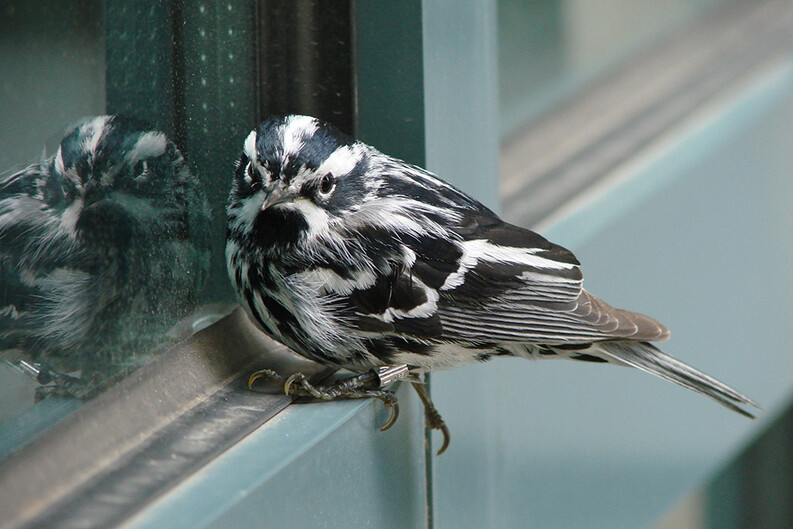LEAP Report: Cities Leading Way on Bird-Friendly Building Policies

A new report published today by the Law, Ethics and Animals Program4 (LEAP) at Yale Law School in partnership with American Bird Conservancy5 (ABC) reveals how local laws and policies are speeding up protections for birds from deadly building collisions. The first-of-its-kind report, Building Safer Cities for Birds: How Cities Are Leading the Way on Bird-Friendly Building Policy, considers how city policies can accelerate the adoption of bird-friendly building design at scale to significantly reduce avian mortality.
“A growing number of U.S. cities and counties have emerged as leaders in advancing bird-friendly building design and practice over the past two decades, in the absence of federal and state action to reduce bird collisions,” said LEAP Executive Director and Research Scholar Viveca Morris6, a co-author of the report. “This report highlights examples and studies the effectiveness of municipalities at the forefront of the bird-friendly building movement, with the hope that their examples can inspire and inform efforts to protect birds from unnecessary collisions elsewhere.”
A staggering number of birds are killed by window collisions each year in the United States, with estimates of up to 1 billion individuals. ABC, a leading authority on preventing bird collisions7, partnered with LEAP on the policy study, with four of its experts contributing to the report: Bryan Lenz, Kaitlyn Parkins, Christine Sheppard, and Anikó Tótha.
The research identified key lessons learned from the experiences of cities that have already passed bird-friendly laws to empower other cities to design more effective policies. The report also features five in-depth case studies of municipal policies passed in New York, New York; Arlington County, Virginia; Madison, Wisconsin; Cupertino, California; and San Francisco, California. Nearly two dozen policymakers, advocates, glass manufacturers, architects, scientists, and community members involved in designing, implementing or working on local policies were interviewed for the report.
Since 2008, more than 20 U.S. cities and municipalities have enacted bird-friendly building policies. At least three bird-friendly building laws were passed this summer, including in Washington, D.C., and the states of Maryland and Maine.

“Policies are critical tools, because they have wide impacts, often beyond their local area. We don’t have the luxury of addressing this problem one building at a time,” said Christine Sheppard, ABC’s Glass Collisions Program Director. Sheppard helped develop ABC’s official rating system9 for measuring threats to birds posed by different building materials — a standard that is now used in many bird-friendly building policies. Commonly approved bird-friendly materials include treatments for glass like fritting and etching, exterior insect screens, exterior blinds, and architectural features that shield large sheets of glass.
According to the report, city bird-friendly building policies vary in scope, design, and comprehensiveness. Existing laws share many of the same limitations, such as those in California that limit regulations to only areas deemed “bird-sensitive” near green spaces and waterways. However, studies show that birds make diffuse use of all parts of urban and suburban environments, so restricting bird-friendly building design to “urban bird refuges” or “bird sensitive areas” falls short of current understandings of the wide-ranging threat of window collisions that birds face throughout the built environment. Most policies include lighting provisions10 to reduce light pollution, which is also a key contributor to bird collisions. None of the bird-friendly building policies studied apply retroactively to existing buildings.
“New rules and innovative strategies for mitigating existing building stocks are urgently needed, especially at high-collisions buildings,” explained Meredith Barges11, Yale MDiv ’23, coauthor of the study and co-chair of Lights Out Connecticut12. “The types of building renovations that trigger most laws will not happen fast enough to save many threatened birds in the decades ahead.”
Local governments could use a range of financial incentives and regulatory policies to advance the adoption of new building technologies by developers and homeowners. One successful example highlighted in the report includes Arlington County, which incentivized bird-friendly architecture in 2020 by adopting a density bonus requirement through its Green Building Incentive Program13. Many other policy tools, such as expedited review and permitting, have yet to be attempted to incentivize the adoption of bird-friendly building materials.
Bird-friendly design can be successfully integrated into green-building policy incentives, according to the report. An estimated 80 percent of U.S. buildings today will still be standing in 2050. Since buildings are responsible for up to 60 percent of carbon emissions, retrofitting buildings for energy efficiency has been widely identified as a critical for climate change mitigation and adaptation. Incorporating bird-friendly building practices into the current once-in-a-generation transformation of cityscapes through net-zero and/or green legislation is probably the best opportunity to accomplish large-scale installation of bird collision deterrence measures, especially because glass is often replaced to improve energy efficiency, according to Morris and Barges.
The report’s findings show that bird collisions prevention can be simple and inexpensive when following recommended science, technology, and standards. The report’s authors and contributors hope its conclusions will inform and inspire better local policies in the future to protect birds from preventable collision-related injuries and avoidable deaths.
Building Safer Cities for Birds: How Cities Are Leading the Way on Bird-Friendly Building Policy is a publication of the Yale Bird-Friendly Building Initiative14, which aims to accelerate the development and adoption of bird-friendly building design. The Yale Bird-Friendly Building Initiative is a collaboration of the Law, Ethics and Animals Program (LEAP) at Yale Law School, the Yale Peabody Museum of Natural History, the Yale Office of Sustainability, and American Bird Conservancy. The Yale Bird-Friendly Building Initiative is supported by a seed grant from the Yale University Planetary Solutions Project15, a campus-wide initiative aimed at addressing complex environmental crises such as climate change and biodiversity loss.


